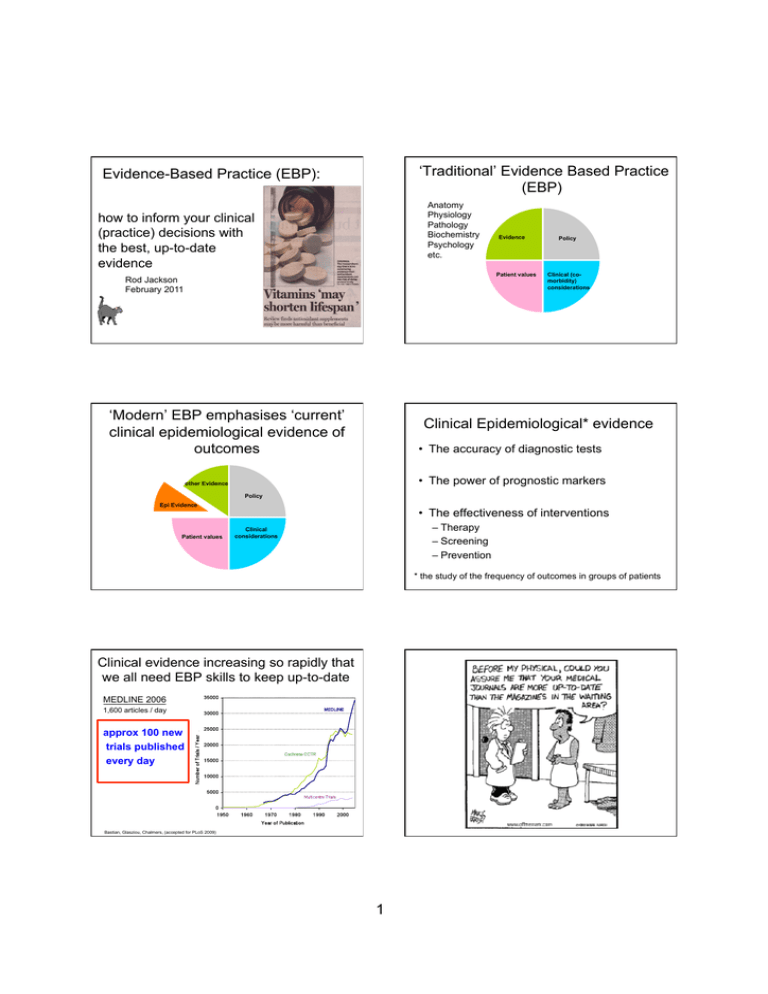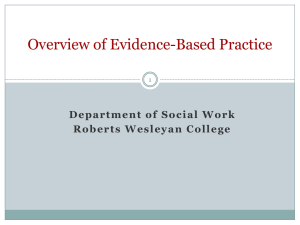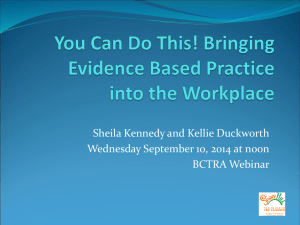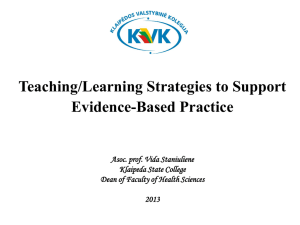Introduction to EBP_030211.pptx
advertisement

‘Traditional’ Evidence Based Practice (EBP) Evidence-Based Practice (EBP): Anatomy Physiology Pathology Biochemistry Psychology etc. how to inform your clinical (practice) decisions with the best, up-to-date evidence Evidence Patient values Rod Jackson February 2011 ‘Modern’ EBP emphasises ‘current’ clinical epidemiological evidence of outcomes Policy Clinical (comorbidity) considerations Clinical Epidemiological* evidence • The accuracy of diagnostic tests • The power of prognostic markers other Evidence Policy Epi Evidence Patient values • The effectiveness of interventions – Therapy – Screening – Prevention Clinical considerations * the study of the frequency of outcomes in groups of patients Clinical evidence increasing so rapidly that we all need EBP skills to keep up-to-date MEDLINE 2006 1,600 articles / day approx 100 new trials published every day Bastian, Glasziou, Chalmers, (accepted for PLoS 2009) 1 Evidence-Based Practice Less that 10% of published evidence is worth reading ‘using the current best evidence from epidemiology to help inform decisions’ • more critically • more systematically About 1/3 of evidence eventually refuted or attenuated The first 4 steps of EBP 1. Ask a focused question. 2. Access (systematically search for) epidemiological evidence to help answer question. 3. Appraise evidence found for its validity, effect size, precision (ideally all the relevant evidence) 4. Apply the evidence: a. amalgamate the valid evidence with other relevant information (patient/community values, clinical/health issues, & policy context) and make an evidence-based decision; and b. Act (implement) the decision in practice About 1/2 of relevant evidence is not implemented GATE: Graphic Appraisal Tool for Epidemiology The 5th step of EBP 5. Audit your practice: check your actual practice against best (evidence-based) practice i.e. the gap between your evidence-based decisions and your actions 1 picture, 2 formulas & 3 acronyms 2 12 the 1st acronym = PECOT: the 5 parts of every epidemiological study the GATE picture: a framework for EBP P Participants Exposure Group E C O Time Comparison Group Outcomes T Graphic Approach To EBP All epidemiological studies can be hung on the GATE frame EBP Step 1: ASK - turn your question into a 5-part PECOT question EBP Step 2: ACCESS the evidence – use PECOT to choose search terms 1. Participants (the patient problem) 2. Exposure (e.g. a therapy) 3. Comparison (there is always an alternative! - another therapy or no treatment… 4. Outcome (e.g. a disease you want to prevent or manage) 5. Time frame (over which you expect a result) 1. Participants (the patient problem) 2. Exposure (e.g. a therapy) 3. Comparison (there is always an alternative! - another therapy or no treatment… 4. Outcome (e.g. a disease you want to prevent or manage) 5. Time frame (over which you expect a result) 16 EBP Step 3: APPRAISE the evidence ACCESSING the best evidence to answer your questions Are you an effective searcher? ‘using the best evidence from epidemiology to help inform decisions’ Are you familiar with MESH terms- the index to PubMed? • more critically (using GATE) • more systematically Are you familiar with Evidence-Based Guideline websites? Cochrane reviews? Journals of Evidence-Based summaries? Google Scholar? PubMed? doing a search is like doing a lab test 3 The 2nd acronym = RAMBO* : assessing bias P P Recruitment ‘using the best evidence from epidemiology to help inform decisions’ Allocation E E C C O T EBP Step 3: Appraise evidence found for its validity, effect size, precision (ideally All the relevant evidence) T O Maintenance • more critically • more systematically Blind or Objective assessment of outcomes 19 * Paul Glasziou Total mortality from trials of β-blockers in 2° prevention after MI. Cumulative meta-analysis of total mortality results from trials of oral β-blockers after MI. Black square & horizontal line correspond to odds ratio (OR) & 95% confidence interval (CI) for each trial. The size of the black square reflects the weight of each trial. The diamond represents the combined OR & 95 CI, showing a 22% reduction in odds of death Size of squares reflect amount of statistical information available at a given point in time Egger, M. et al. BMJ 1997;315:1533-1537 Egger, M. et al. BMJ 1997;315:1371-1374 EBP Step 4: APPLY the evidence by: a. AMALGAMATING the relevant information & making an evidence-based decision:’ the X-factor © 4 X-factor: making evidence-based decisions other Evidence Policy Epi Evidence Patient or community values Clinical or health considerations Epidemiologic evidence Step 4b Clinical / health considerations Patient / community preferences ACT Policy issues expertise: ‘putting it all together’ the art of practice EBP pipeline: from evidence to practice The 5th Step: EBP 360° 1. Ask a focused question. 2. Access (systematically search for) epidemiological evidence to help answer question. 3. Appraise evidence AND then meta-analyse (systematically review) ALL relevant valid evidence. 4. Apply the best evidence: a. amalgamate the valid evidence with other relevant information to make a good decision; and b. ACT on your decision 5. AUDIT your practice (i.e. check your actual practice – ‘actions’ - against ‘best’ evidence-based practice) 1. Evidence = Quality Improvement ACP Journal Club 2005; 142 (2): A8-A10 1. use evidence-based “electronic decision support systems” How can busy practitioners do EBP? 5 2. use evidence-based guidelines (& EB text bks?) 3. use Systematic Reviews MEDLINE 2006/day 1,600 articles 95 trials 4 reviews* *Cochrane Database of Systematic Reviews (SR) per day It is surely a great criticism of our profession that we have not organised a critical summary, by specialty or subspecialty, adapted periodically, of all relevant randomised controlled trials. 1 new SR 1 updated SR Bastian, Glasziou, Chalmers, (accepted for PLoS 2009) Final appraisal task: search for & appraise SRs / meta-analyses using 3rd acronym (FAITH) • Find appropriate studies? • Appraise selected studies? • Include only valid studies? • Total-up (synthesise) appropriately? • Heterogeneity adequated addressed? 33 4. use individual studies The evidence pyramid This course is mainly about studies and syntheses: Evidence-based guidelines the foundations of the evidence pyramid Haynes RB (2001). Evidence-Based Mental Health 4:37-38. 6 CATs (Critically Appraised Topics) GATE-lite: a rapid tool for Step 3 (Appraisal) A tool for documenting the steps of EBP 7





